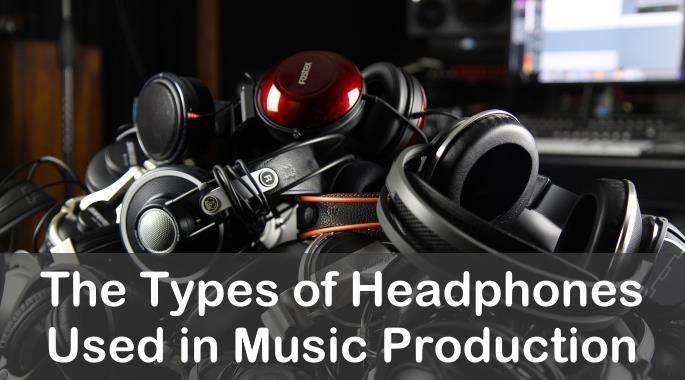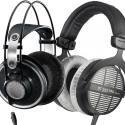The Different Types of Headphones for Music Production Explained

Here we talk about the main types of headphones that are used in studios, from the most advanced recording studios to the simplest bedroom recording setup.
Consumer vs Studio Headphones
Consumer headphones and earphones are often tuned to emphasize certain frequencies for casual listeners. They typically have raised highs and lows for you to better appreciate your favorite songs. While they can work for some, their sound coloration is generally considered as detrimental in music production where you need to hear every part as transparently as possible to make correct adjustments when mixing. In home studios you will often use the same headphones for both recording and mixing This is the reason why studio headphones are categorized differently, and are highly recommended for those who are into recording studio equipment and producing music.
Main Types of Headphones for Music Production
Headphones are mainly categorized in terms how open or closed the ear cups (or ear cans) are, resulting in three main types which include: Closed Back, Open Back and Semi-Open. Below we provide some insights into each of these ear cup configurations as well as their pros and cons. We also added a section that talks about USB and wireless headphones.
-
Best Closed Back Headphones
Closed back headphones are the most common type used in studios. The reason is simple, its solid ear cup prevents sound from leaking out, and it also isolates the listener from outside sound. This makes it perfect for vocalists and musicians who record while listening to a guide track in the studio, reducing the risk of sound leaking into the microphone. Producers and sound engineers can also benefit from the sonic detail that isolation provides, allowing them to focus more on minute details that would otherwise be lost. Finally, it can be useful when listening in areas where noise is unavoidable, like when you're on a busy studio, in a commuter train and many more.
On the flip side, closed back headphones tend to be heavier because of their solid design, which can be a drag when used for long periods. More importantly, due to their lack of natural space and room acoustics, the resulting sound can sometimes be dry or too raw sounding, which after listening in for some time can cause ear fatigue. This is the reason why musicians and sound engineers are advised to have breaks when working on a project, to rest their ears.
Closed back headphones can also have a tendency to 'trap' bass frequencies and therefore over-emphasize them, which is why in professional studios this type is often not used for primary mixing duties but used as a reference - they are used for recording/tracking though. It can be similar to monitoring in a room with no bass traps.
All in all, the closed back headphone are a valuable addition to any studio. It is imperative to at least have one of these handy before you get the other two types.
-
Best Open Back Headphones
As the name implies, these headphones have fully open ear can designs, with perforated metal serving as the cover. These openings allow outside sound to get to the listener, adding natural ambience which many find pleasing and easy on the ears. They also allow some of the sound to go out (including bass frequencies) reducing some of the harshness and dryness that are associated with closed back headphones. Finally, this open back design also tends to be lighter, which can be a great plus when wearing your headphones for a long time.
Open back headphones provide a more natural sound stage, particularly because they don't artificially emphasize bass frequencies. For these reasons, when mixing and mastering is done on headphones it's usually this type that is used.
The downside is that because the leak sound they're not suitable to use when recording/tracking because sound leaks into live mics.
-
Semi-Open Back Headphones
It would be nice if semi-open headphones truly let you enjoy the "best of both worlds", but technically they don't because they are literally open back headphones, with partly opened cans instead of having them fully opened. This means that they get some of the benefits of fully open back headphones, while also reducing its unwanted effects - resulting in a sort of milder in between version. Still, they are in demand because they provide a good compromise for those who want some ambience in their headphones, but do not want too much of it.
Since sound still leaks from partly open ear cans, they won't meet the requirements for quiet recordings, although they are sometimes used for recording vocals to give the singers a more 'natural' sound to sing to. They can provide decent isolation when listening to music on the go, although not as good as closed back. Like open back headphones, you'll need a quiet studio environment to enjoy its ambient sound when mixing and mastering.
Headphones Connectivity
The best headphone brand sets come with 1/8" or 1/4" jacks, but there are some that connect via USB, and there are a few that connects wirelessly.
USB headphones, like USB speakers, have analog to digital converters built into them, which allows them to convert digital audio signal into the analog sound that you hear. While these USB headphones and speakers are good enough for most listeners, they are not up to par with studio headphones when it comes to sound fidelity. And many place the blame on the miniature A/D converters they use, which are mostly designed to please the listening public, instead of reproducing sound as clearly and transparently as possible.
Thanks to improvements in wireless connectivity, companies like Apple no longer sees the need for a 1/4" output port for wired earphones. But this is not the case when it comes to professional recording, where many still cling to their trusted cable. Still there are some manufacturers who have been putting out wireless studio headphones, albeit relatively few. The same issues with miniature A/D converters apply, on top of interference and reliability issues of wireless connections.
Having said all that, it doesn't hurt to give these modern headphones a try, especially if they are from a reputable manufacturer.
Note that earphones are a great way to do real world tests on your tracks, as many of your listeners will probably be listening through earphones. This is an important consideration in the Headphones vs Earphones discussion.
Summary
We hope that this article helps shed light on the different headphone types, along with their connectivity, so you have a good starting point when you're looking to buy headphones for music production.













